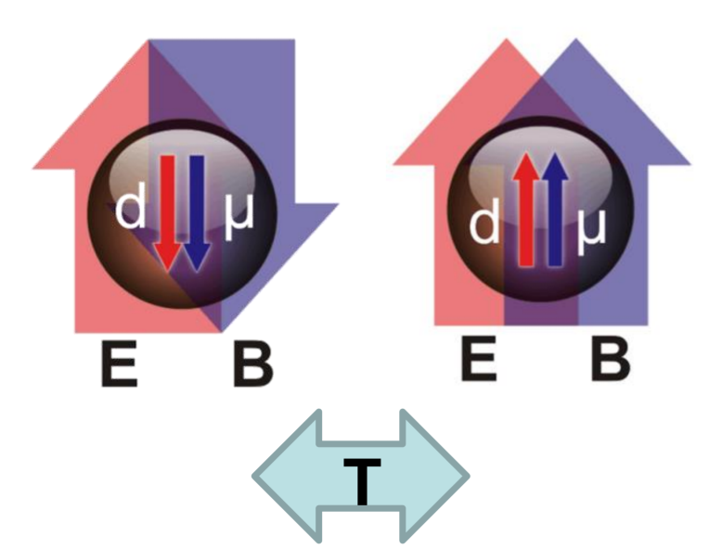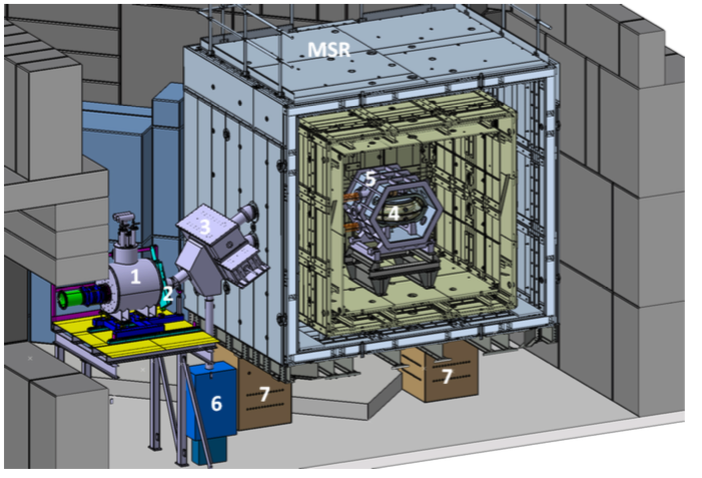Neutron electric dipole moment (nEDM)
Our group is currently playing a leading role in the construction of the next generation n2EDM experiment at the Paul Scherrer Institute, aiming for an order of magnitude improvement in the measurement of the neutron electric dipole moment (nEDM).
The electric dipole moment of the neutron is among the most sensitive probes of CP violating physics beyond the standard model, with a proud history of experimental measurements dating back to 1951. One of the three critical conditions proposed by Sakharov to explain the observed dominance of matter over antimatter in our universe is CP violation: physics must contain some asymmetry between the behaviour of matter and antimatter. The only observed CP violation arises from the complex phase in the CKM matrix, however this has been shown to be far too small to explain the matter-antimatter asymmetry. New physics theories naturally introduce new sources of CP violation to help explain this phenomenon, but this sources typically result in large electric dipole moments of the neutron and other particles. By measuring the neutron electric dipole moment, we are able to constrain this new physics.

Conversely, the standard model allows CP violation in the strong interaction, which would naturally result in a huge neutron EDM. However, this is not observed. The small value of the neutron EDM causes a severe fine-tuning problem in the standard model, the Strong CP problem. This motivates the introduction of the axion, a pseudoscalar particle resulting from the Peccei-Quinn mechanism.
So far, searches for the neutron EDM are yet to produce a nonzero measurement, however it has been said that measurement of the neutron electric dipole moment has historically ruled out more theories of physics than any other experiment.
Currently, we are maintaining and studying our operational active magnetic shielding system and being involved in the production, construction, and commissioning of a caesium magnetometry array.
Active magnetic shielding system
The n2EDM experiment requires a stable magnetic field environment while being located within the challenging environment of a busy experimental hall under severe spatial constraints. These requirements presented substantial physics and technical challenges. We have developed a novel technique to design a magnetic field coil producing an extremely homogeneous field placing by placing wires on an arbitrary grid. This will allow the compensation of huge external field changes up to 50 µT to the level of 1 µT. The active magnetic shield system has been successfully commissioned and operated starting in 2022. external page DOI:10.1140/epjc/s10052-023-12225-z
Caesium magnetometry array
The n2EDM experiment requires precision measurements of its most inner magnetic field environment. This means that the experiment must be constructed from materials that are both clean from large magnetic residue and are insensitive to being magnetised by spark discharges that can occur from the high-voltage system.
In 2023 we joined the internal n2EDM group that is producing, constructing, and commissioning a caesium magnetometry array that aims to surround the neutron storage chambers with 112 optically pumped caesium vapour magnetometers, measuring the magnetic field map with pT sensitivity. This will help to characterise and reduce the field gradients in the central apparatus up to seventh order, largely improving systematics.


n2EDM is the successor to the previous PSI nEDM experiment, which completed its datataking in 2017 and published a new world leading result in February 2020 (external page link to the paper). This represents a continuation of a long tradition of measurements of the neutron electric dipole moment, with the collaboration having in taken over the apparatus used to set the previous world limit, which was systematically refurbished and upgraded, and moved to the new PSI UCN source, the world’s most intense source of ultracold neutrons. In this experiment, our group was responsible for the active magnetic shielding, and made substantial contributions to the data acquisition system and the analysis of the data.
In 2017, we published the first limits on the couplings of hypothetical ultralight axionlike dark matter to the gluon, which would manifest as a temporal oscillation of the neutron EDM. We continue to pioneer new investigations into a wide variety of novel analyses to constrain a variety of new physics, exploiting the data produced by the previous experiment as one of the most sensitive and precise measurements to date.
More information about the experiment can be found external page here.
